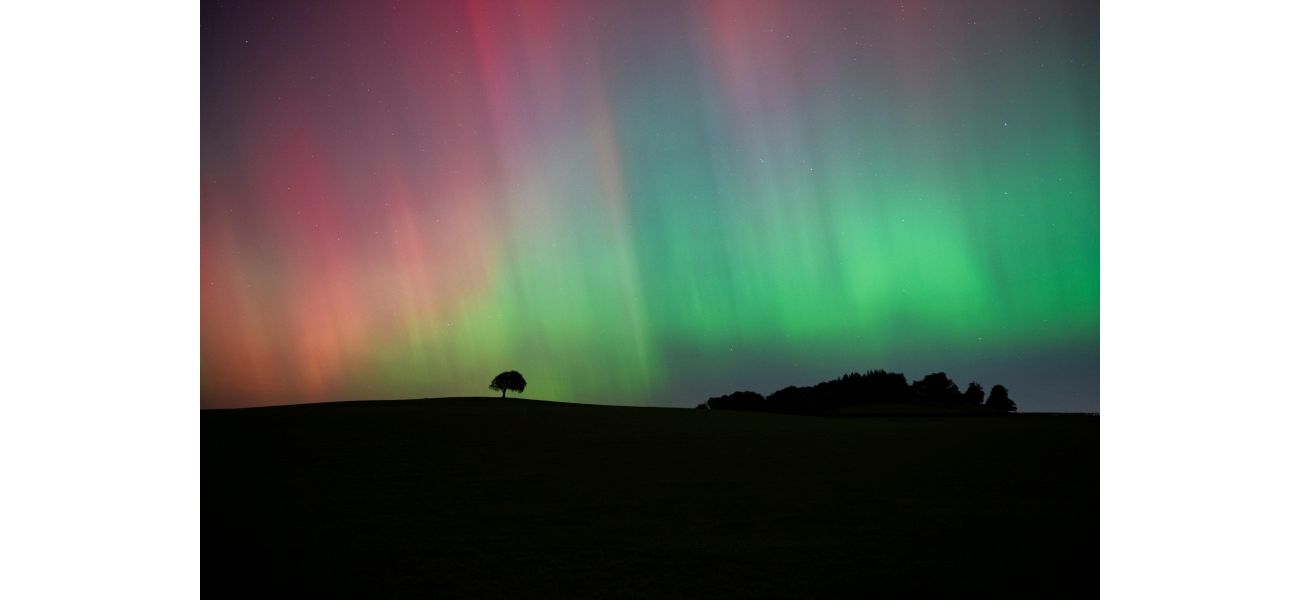Unusual northern lights seen further south than usual are caused by a geomagnetic storm.
Gases in our atmosphere can create different colored lights when interacting with particles: blue and purple from nitrogen, green and red from oxygen.
October 13th 2024.

During a recent period of intense solar activity, a series of strong solar storms hit Earth, causing a spectacular display of colorful lights in the sky. This phenomenon, known as the northern lights or auroras, was visible farther south than usual, reaching as far as Germany, the United Kingdom, New England, and even New York City.
According to Shawn Dahl, a space weather forecaster at the U.S. National Oceanic and Atmospheric Administration’s Space Weather Prediction Center, this was a particularly extensive display. The center received reports of northern lights sightings as far south as New Mexico, making it a truly special year for this natural phenomenon.
Fortunately, there were no reports of any disruptions to power or communications caused by the solar storms. However, NOAA did issue a severe geomagnetic storm alert on Wednesday after detecting an outburst from the sun earlier in the week. Such storms can increase the chances of auroras and may temporarily disrupt power and radio signals.
Despite the continued higher-than-normal activity forecasted by NOAA on Friday, the chances of another overnight show are slim for areas farther south of Canada and the northern Plains states. This begs the question: what exactly causes these stunning northern lights?
According to NOAA, the sun not only sends heat and light to Earth, but also energy and charged particles known as the solar wind. Occasionally, this solar wind can become a storm, as the sun's outer atmosphere releases huge bursts of energy called coronal mass ejections. These solar storms, also known as geomagnetic storms, can interact with Earth's magnetic field and produce beautiful displays of light when particles enter the atmosphere.
Dahl explains that the recent storm was particularly vibrant because of the alignment of the storm's magnetism with Earth's. This allowed for a strong connection between the two and resulted in an intense display of the northern lights.
So why have there been so many solar storms lately? Astronomers say that the sun's activity follows a cycle that lasts about 11 years, known as a solar maximum. We are currently near the peak of this cycle, which could explain the recent surge in solar storms. In fact, just a few months ago, the sun released its biggest flare in almost 20 years, following a series of severe solar storms that triggered auroras in unexpected places across the Northern Hemisphere.
If you're hoping to catch a glimpse of the northern lights, NOAA advises getting away from city lights and heading out during the best viewing time, which is usually within an hour or two before or after midnight. They also recommend keeping an eye out around the spring and fall equinoxes, as these are the best occasions for the solar wind to interact with Earth's magnetic field and produce a stunning display of northern lights.
In conclusion, we can expect more experiences like the one we had last night, as we are still in the peak of the solar maximum. So keep an eye on the sky and get ready for a magical display of colors. And for more news and updates, be sure to sign up for our daily Your Morning Dozen email newsletter.
According to Shawn Dahl, a space weather forecaster at the U.S. National Oceanic and Atmospheric Administration’s Space Weather Prediction Center, this was a particularly extensive display. The center received reports of northern lights sightings as far south as New Mexico, making it a truly special year for this natural phenomenon.
Fortunately, there were no reports of any disruptions to power or communications caused by the solar storms. However, NOAA did issue a severe geomagnetic storm alert on Wednesday after detecting an outburst from the sun earlier in the week. Such storms can increase the chances of auroras and may temporarily disrupt power and radio signals.
Despite the continued higher-than-normal activity forecasted by NOAA on Friday, the chances of another overnight show are slim for areas farther south of Canada and the northern Plains states. This begs the question: what exactly causes these stunning northern lights?
According to NOAA, the sun not only sends heat and light to Earth, but also energy and charged particles known as the solar wind. Occasionally, this solar wind can become a storm, as the sun's outer atmosphere releases huge bursts of energy called coronal mass ejections. These solar storms, also known as geomagnetic storms, can interact with Earth's magnetic field and produce beautiful displays of light when particles enter the atmosphere.
Dahl explains that the recent storm was particularly vibrant because of the alignment of the storm's magnetism with Earth's. This allowed for a strong connection between the two and resulted in an intense display of the northern lights.
So why have there been so many solar storms lately? Astronomers say that the sun's activity follows a cycle that lasts about 11 years, known as a solar maximum. We are currently near the peak of this cycle, which could explain the recent surge in solar storms. In fact, just a few months ago, the sun released its biggest flare in almost 20 years, following a series of severe solar storms that triggered auroras in unexpected places across the Northern Hemisphere.
If you're hoping to catch a glimpse of the northern lights, NOAA advises getting away from city lights and heading out during the best viewing time, which is usually within an hour or two before or after midnight. They also recommend keeping an eye out around the spring and fall equinoxes, as these are the best occasions for the solar wind to interact with Earth's magnetic field and produce a stunning display of northern lights.
In conclusion, we can expect more experiences like the one we had last night, as we are still in the peak of the solar maximum. So keep an eye on the sky and get ready for a magical display of colors. And for more news and updates, be sure to sign up for our daily Your Morning Dozen email newsletter.
[This article has been trending online recently and has been generated with AI. Your feed is customized.]
[Generative AI is experimental.]
0
0
Submit Comment





